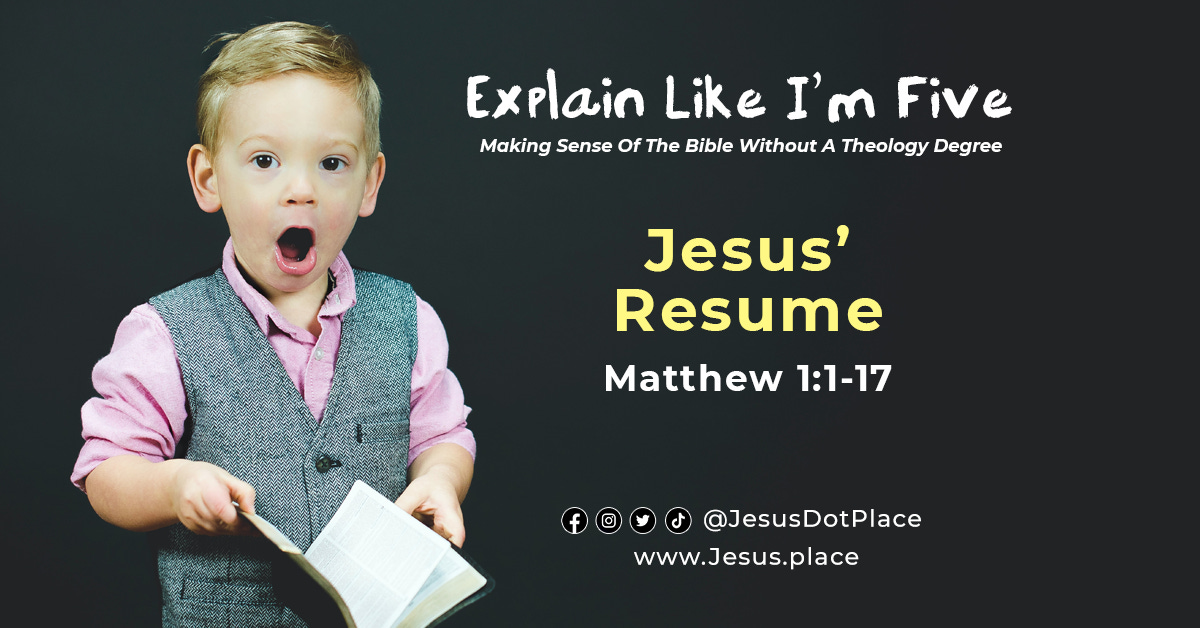Explain Like I'm Five: Jesus' Resume
Matthew 1:1-17
Whoever assembled the New Testament sure wasn’t a marketing guy.
Let me explain.
As someone who has spent many a night strung out in cheap motels, I could always count on a Gideon Bible being in the nightstand drawer. And, on occasion, when I felt low enough to consider divine intervention, I cracked open this Bible.
Now I didn’t start with Genesis. Even I knew that I wanted nothing of that mean Father from the Old Testament. Nope, if I was gonna consider getting straight, I was looking for hand up from Jesus and He doesn’t show up until Part 2 of this Book.
So, I flip thru about ¾ of the Bible until I come upon the New Testament. What I’m hoping to find is some comforting prose (which I later discovered as a Christian was a few more Gospels in). Instead, though, I come across this opening in Matthew 1:1-17 (NKJV):
The book of the genealogy of Jesus Christ, the Son of David, the Son of Abraham:
Abraham begot Isaac, Isaac begot Jacob, and Jacob begot Judah and his brothers. Judah begot Perez and Zerah by Tamar, Perez begot Hezron, and Hezron begot Ram. Ram begot Amminadab, Amminadab begot Nahshon, and Nahshon begot Salmon. Salmon begot Boaz by Rahab, Boaz begot Obed by Ruth, Obed begot Jesse, and Jesse begot David the king.
David the king begot Solomon by her who had been the wife of Uriah. Solomon begot Rehoboam, Rehoboam begot Abijah, and Abijah begot Asa. Asa begot Jehoshaphat, Jehoshaphat begot Joram, and Joram begot Uzziah. Uzziah begot Jotham, Jotham begot Ahaz, and Ahaz begot Hezekiah. Hezekiah begot Manasseh, Manasseh begot Amon, and Amon begot Josiah. Josiah begot Jeconiah and his brothers about the time they were carried away to Babylon.
And after they were brought to Babylon, Jeconiah begot Shealtiel, and Shealtiel begot Zerubbabel. Zerubbabel begot Abiud, Abiud begot Eliakim, and Eliakim begot Azor. Azor begot Zadok, Zadok begot Achim, and Achim begot Eliud. Eliud begot Eleazar, Eleazar begot Matthan, and Matthan begot Jacob. And Jacob begot Joseph the husband of Mary, of whom was born Jesus who is called Christ.
So all the generations from Abraham to David are fourteen generations, from David until the captivity in Babylon are fourteen generations, and from the captivity in Babylon until the Christ are fourteen generations.
I’m sorry…but you don’t start a story like this. I’d rather watch hours of infomercials while coming off a 2-day bender than try to make sense of all these “begots” and names I can’t pronounce.
This just isn’t written for me.
BUT THAT’S EXACTLY THE POINT!
Matthew wasn’t writing his Gospel to me.
He had a specific audience in mind, a 1st Century Jewish/Christian audience. And a genealogy to that audience meant something. Additionally, this particular genealogy was something radically different than what his audience was expecting. The sum added up, but no one would have thought that these parts would add up to this sum.
As is the case with many parts of the Bible, even though this text was written for an ancient audience there is a powerful message here for a modern audience as well.
A message, ironically enough, that would have hit me hard in that motel room had I known the context of it. A message for the poor & the powerless, the depressed & the downtrodden, the outcasts & the miscreants. A message for all of us feeling left behind.
To get at that message let’s start with a brief explanation of Matthew’s audience and the importance of genealogies.
Scholars are in a large agreement that the author (who, for simplification’s sake, I’ll presume to be Matthew) was writing for a primarily Jewish/Christian audience.
And a Jewish/Christian audience would have put great stock in genealogies. As Craig Keener notes, “The Jewish people regarded genealogies as important to establish the purity of their lineage”. Or as theologian N.T. Wright states, “telling the story of one’s ancestry is as important a way of disclosing one’s identity as producing a good curriculum vitae (CV) is when job hunting in the modern world”.
Oh…so a genealogy was the ancient version of a CV or what us less academically inclined might call a resume.
Matthew 1:1-17 is Jesus’ resume.
I don’t know about you, but over my 35 years of being an adult, I’ve had to create many resumes. You might think that it would be as simple as just adding my latest job to the resume, but its never that simple. I’m always tweaking my job history and the description of my jobs to best suit my prospective employer. If I’m applying for a casino job my sales history is featured less prominently and vice versa when I’m seeking a sales job.
I’m never lying on my resume, but I am trying to put my best foot forward. I’m assembling the parts of my work history to best fit the job I’m applying for.
So Matthew is putting forward Jesus’ genealogy as proof that He is worthy of being the Jewish people’s Messiah. And he starts off strong by tying Jesus into the lineage of Abraham and David. Abraham is who God made His original covenant with and David represents the peak of Israel’s history.
But just as I took liberty with arranging my work history, Matthew does the same with Jesus’ lineage and theologians & laypeople alike have been trying to make sense of Matthew’s genealogy ever since.
I don’t have the space here to do justice to how perplexing Matthew’s genealogy is, but I’m a big fan of how theologian Raymond Brown addresses some of these issues in his book, The Birth of the Messiah:
“Who Was Jesus’ Grandfather? This question, which may seem naively curious, is raised by the blatant disagreement between Matt 1:16 which identifies Joseph’s father as Jacob, and Luke 3:23, which identifies that gentleman as Eli.”
“Fourteen – The Magic Number…even God did not arrange things so nicely that exactly fourteen biological generations separated such crucial moments in salvation history as the call of Abraham, the accession of David, the Babylonian Exile, and the coming of the Messiah.”
“Could Matthew Count? Although Matthew (1:17) insists on the presence of the 3x14 pattern of generations…when one actually counts the generations in the three sections of the list, it seems Matthew’s arithmetic leaves something to be desired.”
Frankly, none of that ever bothered me when I became a Christian (and it doesn’t seem to bother Mr. Brown or most scholars as well). Yes, this is another thing for atheists to argue with, but when you can wrap your mind around the Incarnation and the Resurrection of Jesus, Matthew’s creative genealogy is small potatoes.
But what did catch my attention, as a savage seeking Jesus’ salvation, was the cast of characters that Matthew included. He’s got some truly shady dudes in this lineage; go look up Rehoboam, Jehoram, or Ahaz…they wouldn’t have made my resume if I was applying for the job.
But who really stands out are the four women that Matthew mentions: Tamar, Rahab, Ruth, and Bathsheba.
First off, Mr. Brown states “their presence in a genealogy is unusual according to biblical patterns”. Typically, in the Jewish world, genealogies would be entirely male. But it’s not that they are just women, but what type of women they are.
As Rodney Reeves writes in his commentary, “Tamar acted like a prostitute to become pregnant by her father-in-law; Rahab was a prostitute; Ruth approached a man to sleep with him; Uriah’s wife, Bathsheba, committed adultery with David.”
Yikes!
Why is Matthew including these four?
Mr. Brown proposes that these four women share something in common with Mary the mother of Jesus: “(a) there is something extraordinary or irregular in their union with their partners – a union which, though it may have been scandalous to outsiders, continued the blessed lineage of the Messiah; (b) the women showed initiative or played an important role in God’s plan and so came to be considered the instrument of God’s providence or of His Holy Spirit.”
Matthew is saying, God is doing salvation His way.
It’s not going to be some sanitized lineage that will play well in the Temple (or a 21st Century church). Nope, humanity is a mess, and I’m going to drop my Son right into the middle of it as a descendant of the wicked and the debauched.
And guess what else? He’s going to be born to a virgin as well!
As Mr. Reeves writes, “Matthew wants to make it plain: Jesus didn’t “become” one of us. He is one of us—all of us—the good, the bad, and the ugly. His genealogy proves it.”
I know that prior to encountering Jesus, I felt alienated in this world. I tried to feel whole by chasing artificial highs wherever I could find them, but it never filled me. And at my worst, it landed me in cheap motels wondering if there was any hope to be found in this Book in the nightstand.
Yes, there is hope.
A scandalous amount of hope.
I like telling these stories because they aren’t readily apparent. We aren’t 1st Century readers. We’re modern people and many of us are just struggling to get by.
As a Christian, my job isn’t to fix people; its to turn people on to the Fixer.
To share with them this outrageous good news in short little snippets about Jesus. To share with them Jesus by loving on them. And to love them as they are, not as we wish them to be. To let them know that no one gets left behind because He came for all of us and all of us have a role in God’s plan.
At least that’s how I read His resume.
Amen.
Photo Credit:
https://drinkswithdeadpeople.com/wp-content/uploads/2015/09/Gideons.jpg
References:
Brown, R. (1993). The birth of the Messiah: a commentary on the infancy narratives in Matthew and Luke: new updated edition. Doubleday.
Keener, C. (2009). The Gospel of Matthew: a socio-rhetorical commentary. Eerdmans.
Reeves, R. (2017). The Story of God Bible Commentary: Matthew. Zondervan.
Wright, N.T. (2004). Matthew for everyone, part 1. Westminster John Knox.



